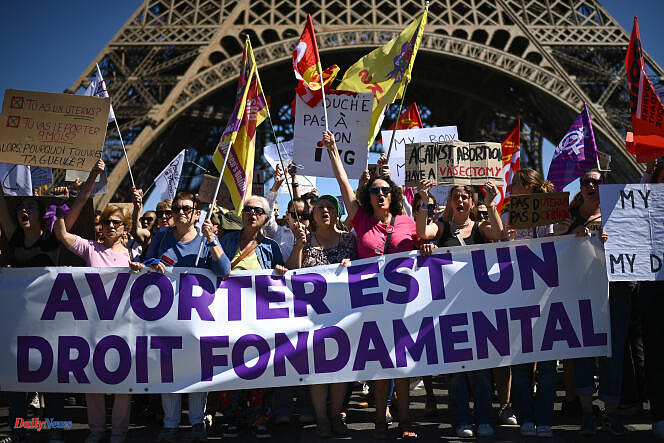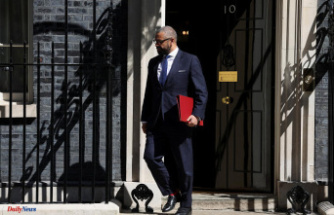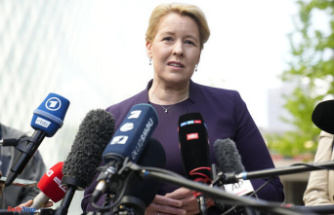The Senate must decide on Wednesday February 28 on the inclusion of voluntary termination of pregnancy (abortion) in the Constitution. The outcome remains undecided, because the text must be absolutely identical to that voted by the National Assembly. However, the majority right-wing senators, after having modified the text in February 2023 to transform the notion of “right” into “freedom” to resort to abortion, are now hesitant to approve the wording of “guaranteed freedom”.
Protection of abortion had been proposed by several French political groups in 2022, in reaction to the decision of the Supreme Court of the United States to overturn the Roe vs. Wade ruling, which guaranteed access to abortion at the federal level. 'abortion. Acquired since 1975 in France by the Veil law, the right to abortion was strengthened by law in 2022, which provides for the extension of the period to the fourteenth week of pregnancy.
But despite these advances in the law, access to abortion remains fragile in practice: the use of abortion, on the rise in recent years, remains unequal depending on the profile or social level of women and the availability of structures. near their place of residence. The notion of “guaranteed freedom” could raise the question of the means allocated to this public health policy.
In 2022, 234,300 abortions were recorded in France, i.e. 17,000 more than in 2021 and around 7,000 more than in 2019, according to the Department of Research, Studies, Evaluation and Statistics ( Drees). The abortion rate exceeds the 2019 level – which was at the time the highest since 1990.
IVGs remain the most common among young women, with a recourse rate of 26.9‰ for 20-24 year olds and 28.6‰ for 25-29 year olds. Between 2021 and 2022, the recourse rate increased “for all adult women with a more marked increase among 20-29 year olds”.
The extension of two weeks (from twelve to fourteen) of the legal appeal period, provided for in the law of March 2022, “is not enough to explain this increase”, notes the Drees, because the most late abortions represent “less than 'a fifth of the surplus observed compared to the year 2021'.
Until 2005, abortions were carried out entirely in hospitals and clinics. They can now also be carried out in health or family planning and education centers, or in practices in town (general practitioners, gynecologists, midwives):
The abortions carried out in the city were carried out in total by 1,932 approved practitioners (including 832 gynecologists, 662 general practitioners and 420 midwives). “Related to the number of practitioners installed in practices, this represents 2.9% of general practitioners and gynecologists and 3.5% of midwives,” calculated the authors of the 2020 parliamentary report, Marie-Noëlle Battistel and Cécile Muschotti, who sound the alarm:
“The main explanation for the difficulties in accessing abortion essentially results from disinterest in a medical procedure that is little valued and considered to be of little value. The burden of effectively maintaining this right rests essentially on a handful of activist practitioners, many of whom will soon retire. »
In 2016, a decree extended the practice of medical abortion to midwives. The 2022 law authorizes them to perform instrumental abortions.
“As for abortion outside health establishments, that is to say medical abortion in town or by aspiration in health centers, there is an increase in supply, and the arrival of midwives in private practice is spectacular", however tempers Sophie Gaudu, co-founder of the Network between the city and the hospital for orthogenics (Revho), which lists the structures which perform abortions and offers training on abortion to health personnel. “Even if I find that, over the last ten years, with the exemption from user fees, the extension of deadlines, there have been many improvements in access to abortion, but a lack of recognition remains , particularly to attract young practitioners. »
Another problem is that the choice of method of abortion is not always guaranteed. The evolution of methods shows a continuous progression of the medicinal technique, lighter in terms of care (the patient takes two medications orally a few days apart to expel the embryo).
But Nathalie Trignol-Viguier emphasizes that, in practice, some centers use the medicinal method systematically, without offering alternatives:
“These practices are established for good or bad reasons. Either because there are not enough professionals who can achieve aspirations and, therefore, rather than offering anything, we use degraded strategies [medication methods], or because there is a real non- willingness to practice aspiration. »
Access to abortion suffers from the current context of unequal access to care on French territory. Thus, the 2020 parliamentary report points to “infrastructures [which] do not meet the needs in certain departments, which generates territorial inequalities which are difficult to accept”. With the resulting extension of consultation times and longer journeys for women. Not to mention the practitioners who refuse to perform abortions under the specific conscience clause. In France, the time between the first request for an abortion and its completion is on average 7.4 days. However, this delay “can vary from three to eleven days on average depending on the region”, underline the authors of the parliamentary report.
Added to this are the closures of several structures in recent years. Family Planning estimates that, over the past fifteen years, 130 abortion centers have closed their doors. Le Monde, for its part, counted the closure of 45 hospital establishments practicing abortion between 2007 and 2017. As the orthogenic centers are mainly attached to the maternity wards of public hospitals, the dynamics of hospital restructuring and specialization of maternity wards (between 1996 and 2019, the number of maternity hospitals in France fell from 814 to 461, according to Drees) mechanically caused a decline in abortion centers in public hospitals.
How does this impact regionally? According to the 2020 parliamentary report, territorial disparities remain and “women from rural areas are the first affected by this deficit of practitioners”. In urban areas, women “are not spared either due to the general insufficiency of reception capacities and the variable policies implemented by establishments”, specifies the report.
In terms of distribution of the practice across the entire territory, the Drees also points to “regional disparities” which “remain” with the use of abortion which varies from simple to more than double in mainland France. The minimum is observed in Mayenne (9.9‰) and the highest rates are in the South-East (23.5‰ in Var) and in Ile-de-France (22.4‰ in Seine-Saint -Denis). Abortion rates are significantly higher overseas, led by Guyana (48.7‰) and Guadeloupe (40.6‰).
Finally, Drees highlighted in 2019 that women with the lowest incomes had more recourse to abortion. A cross-reference with the tax data of women who had an abortion in 2016 highlighted “a clear correlation between standard of living and abortion; the most precarious women use it significantly more than the wealthiest. » The 10% of women with the highest standards of living have an abortion rate 11 points per 1,000 lower than that of the 10% of women with the lowest standards of living.












